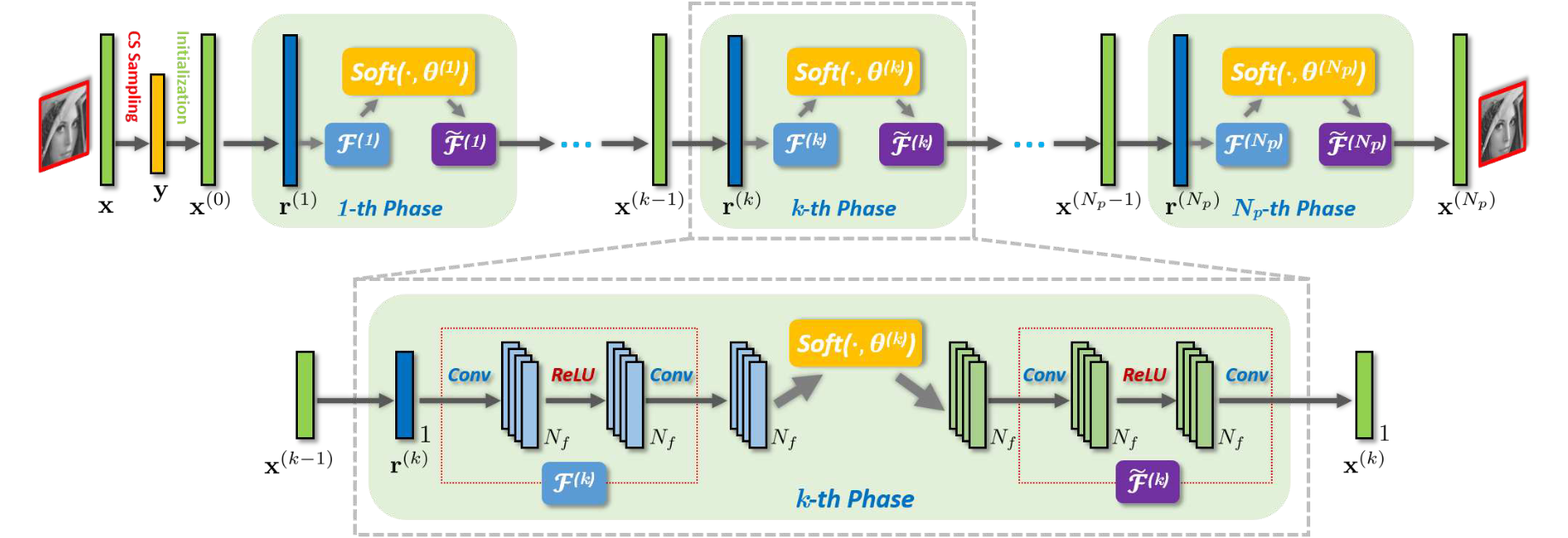论文阅读 | ISTA-Net
ISTA-Net
KAUST CVPR’18
Introduction
- 利用信号固有的冗余性,CS 策略可以边采样边压缩,相较于传统 JPEG 技术等“先采样后压缩”策略,节省带宽和存储空间
- CS 证明,只要信号在某些变换域中表现出 稀疏性 (sparsity),则可以用比 Nyquist 采样定理更少的不等距采样来高概率地重建信号。
- 传统方法利用一些 结构化稀疏 (structured sparsity) 作为图像先验,然后以迭代的方式求解 稀疏正则化 (sparsity-regularized) 优化问题。
- 该工作将用于一般 \(\ell_1\)-norm CS 重建模型的 ISTA 映射到一个深度网络中。
- 该工作使用了非线性、可学习的稀疏变换,和开发了一种高效的策略解决非线性变换的 近端映射 (proixmal mapping)。☞
- ISTA-Nets 可认为是两种 CS 方法 (optimization-based 与 non-iterative algorithms,即 network-based) 之间的桥梁
Preliminary
CS Reconstruction
其中
- \(\text{x}\): original signal
- \(\text{y}\): randomized CS measurements
- \(\Phi\in\mathbb{R}^{M \times N}\): linear random projection
- define CS ratio as \(\frac{M}{N}\)
从 CS 测量域到原始信号域的逆映射问题是欠定的 (ill-posed),即解不稳定或不唯一。
Related Work
讨论两类 (optimization-based 与 non-iterative algorithms) 压缩感知重建方法。
Optimization-based
Given:
Reconstruct the original image \(\textbf{x}\) by solving the following optimization problem:
向量 \(\Psi \textbf{x}\) 解释是表示 \(\textbf{x}\) 关于某个变换 \(\Psi\) 的 变换系数 (transform coefficients),比如通过 \(\ell_1\)-norm 用于约束稀疏性,\(\lambda\) 为正则化系数。后面这一项是正则项,除促进稀疏性外,避免过拟合。
由于自然图像是 非平稳 (non-stationary) 的,经典的 固定域方法 (DCT, 小波, 梯度域) 性能不佳。许多工作将关于变换系数的额外的先验纳入 CS 重建框架中。
存在的问题
- 迭代次数多,计算复杂性
- 依赖先验
Network-based
…
Methodology
Traditional ISTA
“The iterative shrinkage-thresholding algorithm (ISTA) is a popular first order proximal method, which is well suited for solving many large-scale linear inverse problems.”
迭代收缩 (软) 阈值算法 (ISTA) 是一种一阶近似方法,非常适合求解许多大型线性反问题。
最终 ISTA 是要解决一个近端映射问题
提到,由于 \(\Psi\) 可能是非正交 (如果是矩阵) 乃至非线性的,\(\text{prox}\) 的计算成本很高。且受限于 \(\rho\) 和 \(\lambda\) 等超参 (非参数化 ??) 的手动设置。
ISTA-Net
思路是把 ISTA 的每一轮迭代 (steps) 映射到一个 DNN 的 phases,当然这样一来 steps 是固定的。
有点像,Attention 一次性处理了 RNN 中串行处理的向量序列。
整体架构如下图所示。

ISTA-Net 将手动设置的 \(\Psi\) 建模为一个参数化的非线性变换,记为 \(\mathcal{F}(\cdot)\),实现为
卷积层 \(N_f\) 个通道,对应 \(N_f\) 次滤波。学习率 \(\rho\) 在 phases 间可变。
Assumption In the context of image inverse problems, one general and reasonable assumption is that each element of \((x^{(k)} − r^{(k)})\) follows an independent normal distribution with common zero mean and variance \(\sigma^2\).
在使用网络对正则项建模的过程中还提到一个 \(soft\) 函数,这个 \(soft\) 是 软阈值函数,由原文 Eq. (9) 求导得到。
引入 \(\mathcal{F}\) 的左逆 \(\tilde{\mathcal{F}}\),即 \(\mathcal{F}\circ\tilde{\mathcal{F}}=\mathcal{I}\)
这个逆运算的成立由损失函数进行约束。
Initialization
使用线性映射而非随机初始化。
从而 \(\forall{\textbf{y}},\textbf{x}^{(0)}=\textbf{Q}_{init}\textbf{y}\)
损失函数由 \(\ell_2\) 和 \(\mathcal{L}_{constraint}\) 组成。约束形式为
注意 Compressive Sensing 是 Inverse Problem,其训练数据对格式为 \(\{(\textbf{y}_i, \textbf{x}_i)\}\).
ISTA-Net+
使用更深的网络进行建模。

Assume that
其中
- \(\textbf{w}^{(k)}\): 补充高频
- \(\textbf{e}^{(k)}\): 噪声
(看完 ASP-Net 再回来看,引入 \(\mathcal{G}\) 补充高频与 ASP-Net 引入 \(\mathcal{B}\) 进行 deblocking 是否是类似的,都可视为某种去噪过程呢)
Summary
代码写得非常清晰,不再赘述。
思考,这个模型是不是压缩感知重建的标准模板。即


 浙公网安备 33010602011771号
浙公网安备 33010602011771号